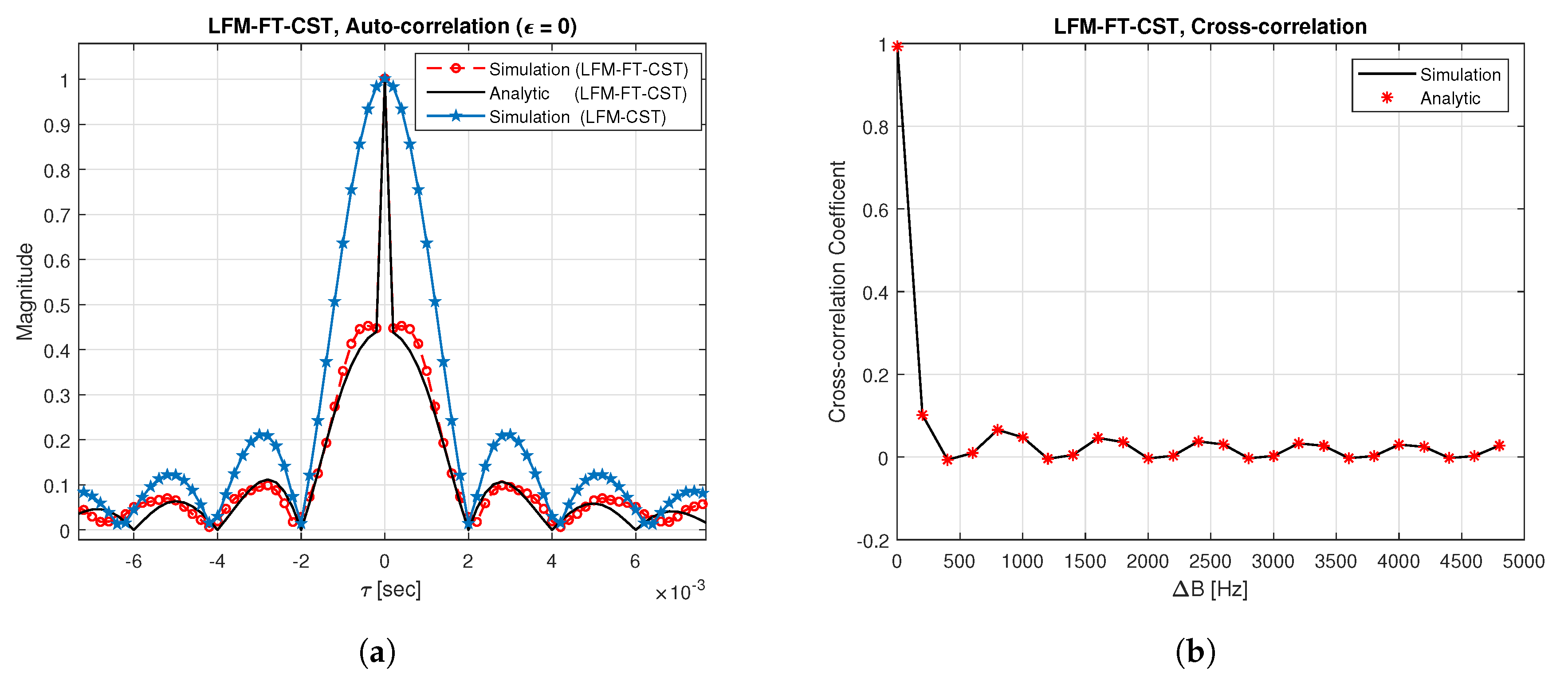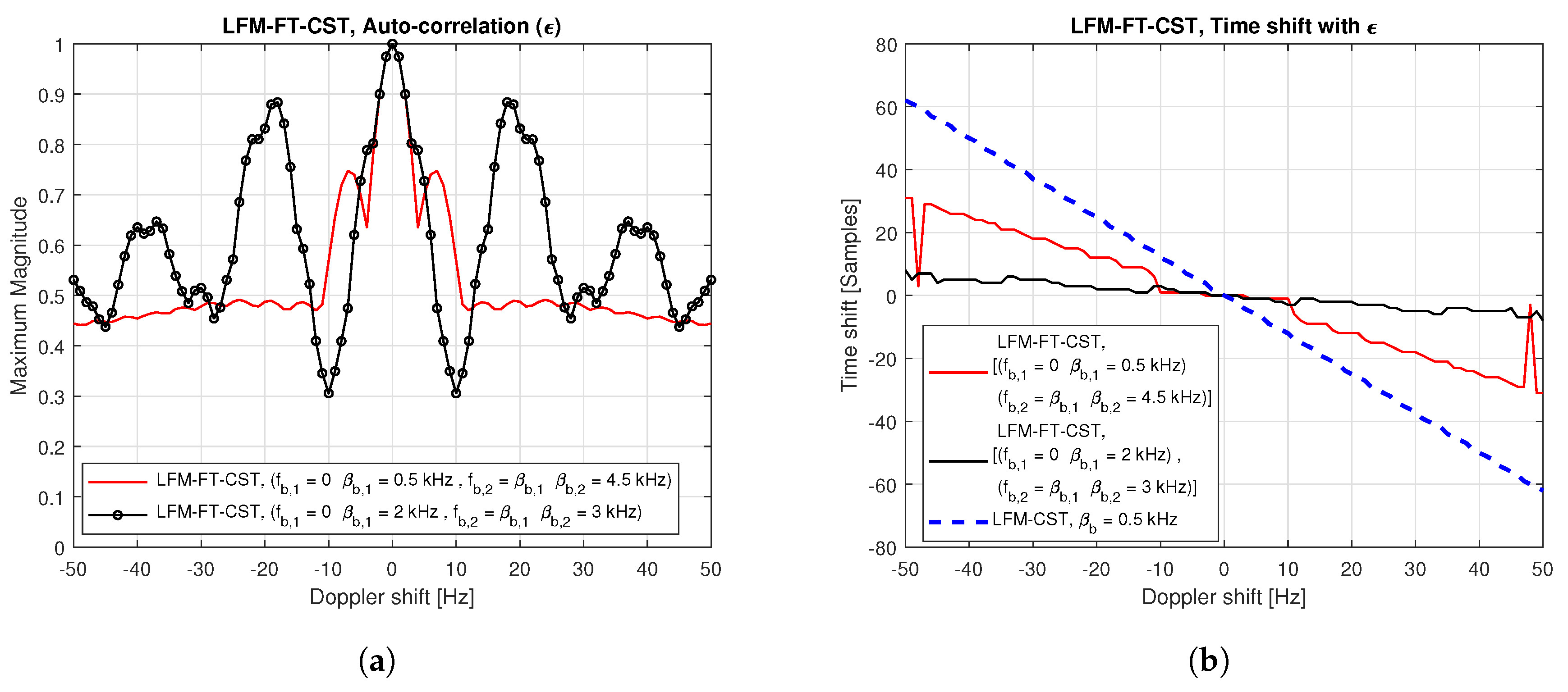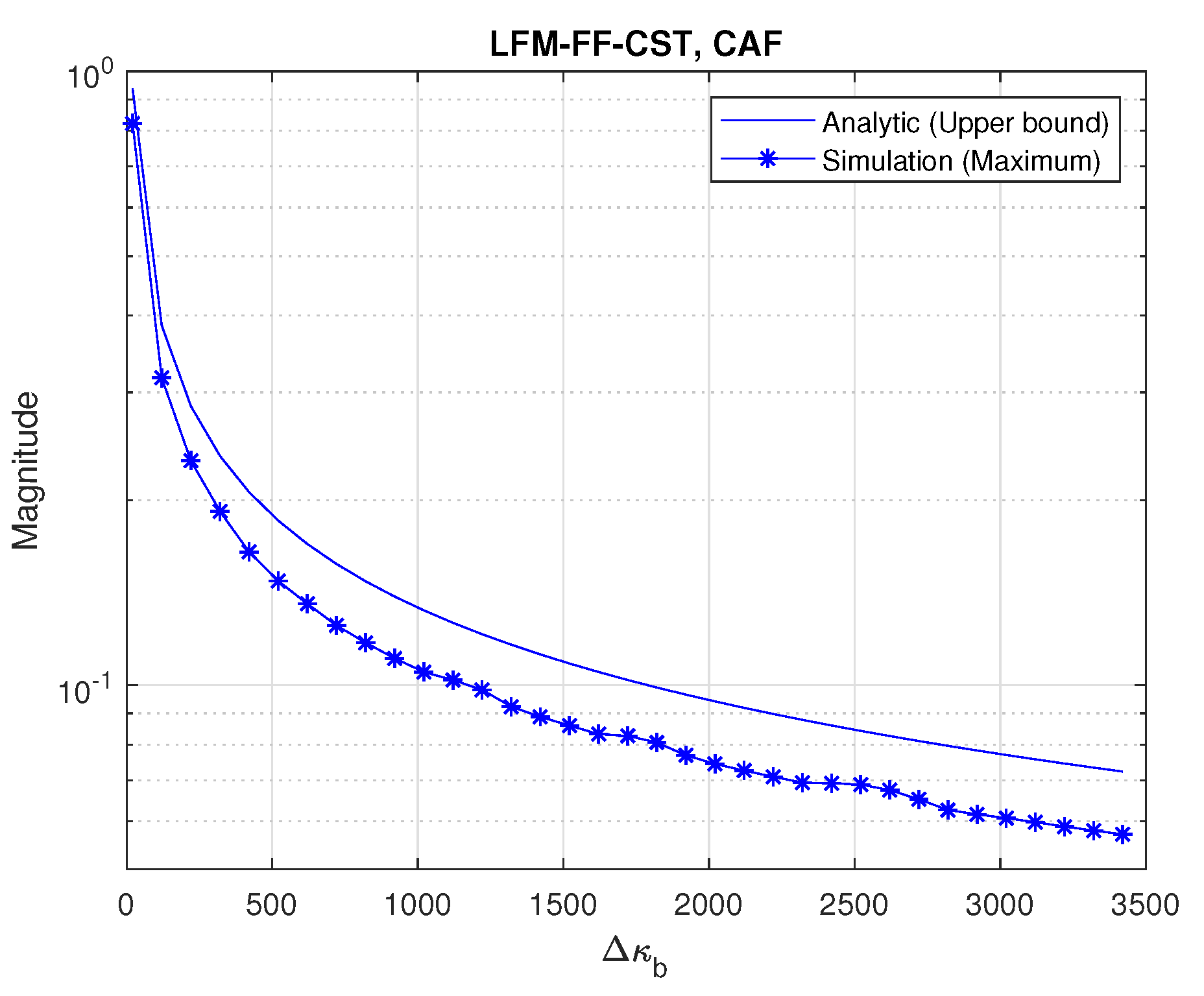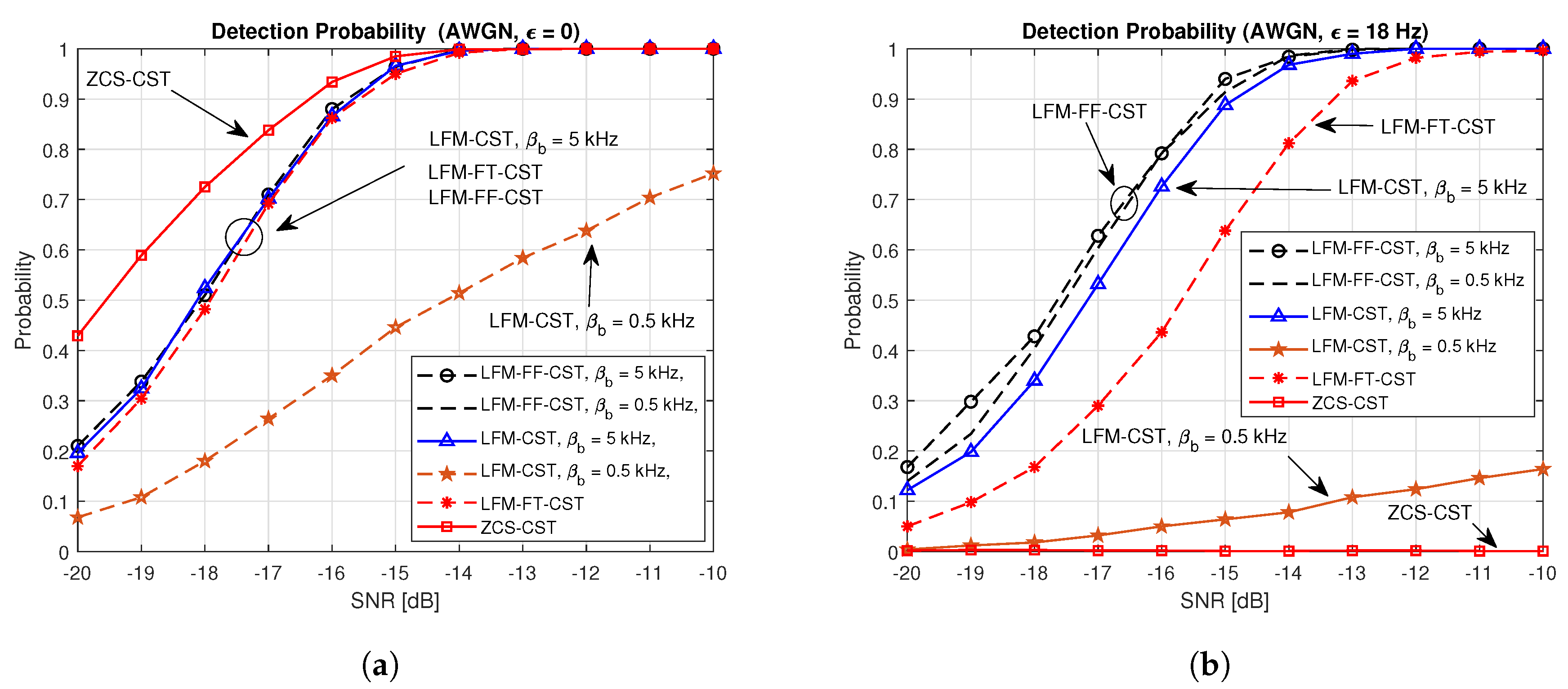1. Introduction
With the tremendous scientific and technological advances over recent decades, a wide range of underwater exploration applications have emerged. The scientific exploration spans multiple disciplines, such as coastal surveillance, disaster prevention, oil and gas exploration, and environmental monitoring. With the application of data collection such as environmental/security data, and real-time videos, it may require to deploy autonomous underwater vehicles (AUVs) or sea gliders in the ocean over a long duration [
1,
2,
3,
4,
5,
6,
7,
8]. To establish a communication link between nodes in underwater networks, several communication media such as cables, electromagnetic waves, optical waves, and acoustic waves have been used. In underwater wireless communication systems, acoustic waves are extensively used since acoustic waves propagate well in underwater and can traverse large distances. However, compared with terrestrial radio frequency communication systems, underwater channels are severely affected by several transmission losses (absorptive loss, geometric spreading, and scattering loss). The acoustic wave propagates through multipath channel caused by the reflections on the surface of the ocean and refractions between different layers due to the depth-varying sound speed. The temporal variability of the ocean combined with the low sound speed in water may induce significant Doppler shifts [
9,
10]. In underwater communication, the low frequency band is normally used because the attenuation of acoustic waves increases with frequency.
Spatial frequency reuse was considered for large area coverage in bandwidth-limited underwater acoustic networks [
11]. Based on the acoustic propagation laws (dependence of path loss on both distance and frequency), the analysis offers a relatively simple tool for the design of autonomous underwater systems based on cellular network architectures. In [
12], a channel sharing protocol for underwater wireless sensor networks based on a cellular type of architecture was proposed by leveraging the long delays and signal absorption in the underwater channel, resulting in an increased efficiency of bandwidth utilisation. In [
13], the cell size and frequency reuse pattern are investigated to support a desired number of users operating over a given area in an underwater acoustic cellular (UAC) network. In [
14], the concept of frequency reuse is investigated to increase both the coverage and capacity in a UAC system. In [
15], it is shown that the capacity of a UAC system based on orthogonal frequency division multiplexing (OFDM) is higher than that of a single carrier system. A code-division multiple access (CDMA)-based underwater acoustic cellular system and cellular underwater wireless optical CDMA system were proposed in [
4,
16,
17,
18].
In a UAC system, the user equipment (UE) should perform downlink (DL) synchronisation and cell searching using the received preamble to establish a communication link. The preamble is normally transmitted from the UBS in the DL header for synchronisation and cell search. Many different types of sequences have been developed for synchronisation since synchronisation requirements vary for each application. The Barker sequence was used for preamble design in the underwater acoustic channel. However, it has some limitations because it is usually modulated with tone carrier, which is easily distorted in underwater channels [
19]. An M sequence has been widely used for synchronisation in terrestrial communication because it exhibits a good autocorrelation property. A complex polyphase sequence, Zadoff-chu sequence (ZCS), has been widely used for synchronisation in OFDM systems because it has an ideal autocorrelation and small cross-correlation properties. However, the ZCS is sensitive to Doppler shift, which is unavoidable in UAC systems [
20]. In an underwater acoustic channel, chirp signals, such as linear frequency modulation (LFM) and hyperbolic frequency modulation (HFM), are often used for signal detection due to their robustness against Doppler shift [
21]. Although LFM signals have been widely used in radar and sonar surveillance applications, they have not yet been used for the design of preamble in cellular networks. In cellular networks, a large number of preambles are required to distinguish the preambles transmitted from different base stations at the mobile station.
For underwater acoustic systems, many synchronisation techniques such as signal detection, timing/frequency acquisition, and Doppler scale estimation/compensation have been developed [
21]. However, there is a dearth of research on the cell search technique (CST) for estimating the physical cell identity (CID) of the UBS. The conventional terrestrial cellular system’s CSTs cannot be applied to the UAC system because the slow propagation of acoustic waves produces a large Doppler spread and/or shift. In [
22], two different types of CST were proposed for the UAC system, i.e., ZCS-based CST (ZCS-CST) and LFM-based CST (LFM-CST). Since ZCS-CST is based on the ZCS, it can be considered as a modified version of the CST in the LTE systems. In LFM-CST, by changing the parameters of the LFM signal (frequency sweeping parameter and starting frequency), multiple LFM preambles are generated to map the CIDs to these preambles. The LFM-CST was seen to perform better than the ZCS-CST when a Doppler shift exists. However, in the LFM-CST, full bandwidth cannot be assigned to all preambles since the CID is mapped to its frequency sweeping parameter. Thus, in the LFM-CST, system bandwidth cannot be optimally utilised. The CID detection probability will decrease when the preambles with a small value of frequency sweeping parameter are used. The range resolution decreases as the value of the frequency sweeping parameter decreases. Furthermore, the correlation peak in the LFM signal is shifted from the correct position, with an increase in the Doppler shift.
In order to overcome these limitations, two different types of CST are proposed in this paper: CST based on linear frequency modulation with full bandwidth in the time domain (LFM-FT) and CST based on linear frequency modulation in the frequency domain (LFM-FF). In both the LFM-FT-CST and LFM-FF-CST, multiple LFM preambles are generated by changing the frequency sweeping parameters of the LFM signal as in the previous LFM-CST. However, unlike the LFM-CST, full bandwidth is used for all the preambles in the LFM-FT-CST. In the LFM-FT-CST, the preambles are directly generated in the time domain with two different frequency sweeping parameters, one for each of the two halves of the preamble duration. In the LFM-FF-CST, the LFM waveforms are generated in the frequency domain with different frequency sweeping parameter and are converted into time-domain signal via an inverse discrete Fourier transform (IDFT). All the preambles in both the LFM-FT-CST and LFM-FF-CST have the same power.
The rest of this paper is organised as follows. Two previous cell search techniques for UAC systems are summarised in
Section 2. Two cell search techniques (LFM-FT-CST and LFM-FF-CST) are proposed for UAC systems in high Doppler environments in
Section 3. The auto-correlation and cross-correlation functions of LFM-FT-CST are analysed and compared with the simulation results. The ambiguity function (AF) and cross ambiguity function (CAF) of LFM-FF-CST are derived and compared with the simulation results. In
Section 4, the performances of the proposed CSTs are evaluated for AWGN and multipath channels using a Bellhop channel simulator. The conclusions are drawn in
Section 5.
2. Preliminaries
Figure 1 depicts the typical receiver processing modules in OFDM-based underwater communication systems. One of the most important tasks of the receiver is to detect the arrival of the useful signals from the transmitter because underwater acoustic channels are known to be one of the most challenging channels for communication. An LFM waveform is usually used for preamble detection because it is known to be robust to the Doppler effect. As illustrated in
Figure 1, the received signal carrying a detection preamble is correlated with the bank of locally generated preambles to perform signal detection and obtain coarse timing. In the UAC system, the UE should also detect the CID of the serving UBS. Once the preamble is detected, the receiver starts recording the waveform from the detected timing instant. The receiver estimates the fine timing by using the received synchronisation preamble and estimates the Doppler scale factor because the transmitted signal is usually dilated or compressed at the receiver end. Using the estimated Doppler scale factor, the Doppler scaling effect is compensated by resampling the received signal. The estimation and compensation of integer and fractional carrier frequency offsets (CFOs) are performed using the repetitive patterns of the synchronisation preamble. The transmitted data are recovered with a frequency-domain equalizer using the pilots inserted in each OFDM symbol. In this paper, we will focus on the CST for estimating the CID and correct timing of the UBS because many synchronisation techniques for underwater acoustic channels are already available.
Next, the previous CSTs (ZCS-CST and LFM-CST) developed for a UAC are summarised [
22]. In the ZCS-CST, cell searching is performed independently of the preamble detection. After completing signal detection using the LFM waveform, cell searching is performed using the received ZCS. In this technique, like the LTE system, the root index of the ZCS is used to map the CID. In the absence of Doppler frequency shift, due to the good correlation property of ZCS, a high CID detection probability is achieved regardless of AWGN and multipath channels. However, when Doppler shift exists, the detection probability of the ZCS-CST decreases significantly. In LFM-CST, the received LFM waveform is used to perform cell search in conjunction with signal detection and coarse timing detection. Here, multiple LFM preambles are generated to estimate different CIDs from the received LFM waveform (at sensor node). The CID of the UBS is mapped to the starting frequency and frequency sweeping parameters of the LFM waveform. The received signal is then correlated with a bank of locally generated LFM waveforms with different parameters for signal detection and CID estimation. The LFM-CST shows better performance (higher CID detection probability) than the ZCS-CST in the presence of a Doppler shift, because the LFM waveform is insensitive to the Doppler shift.
However, the LFM-CST has the following weakness. In the LFM-CST, multiple LFM preambles are generated to distinguish a serving UBS from adjacent UBSs. The multiple LFM preambles are generated by changing the frequency sweeping parameter of the LFM waveform. The CID of a UBS is mapped to the frequency sweeping parameter of the LFM waveform. Thus, the UBSs are assigned different frequency sweeping parameters, implying that different bandwidths are used for the UBSs. Full bandwidth cannot be assigned to all the UBSs. Subsequently, the CID detection probability will vary depending on the frequency sweeping parameter assigned to the UBS. The detection probability will be the highest when the frequency sweeping parameter is equal to its system bandwidth, because the LFM waveform is qualified as a pulse compression waveform when the BT product (time-bandwidth product) is much greater than one. The detection probability will decrease as the value of frequency sweeping parameter decreases. The range resolution also decreases with a decrease in the value of the frequency sweeping parameter.
The LFM waveform is known as a Doppler-insensitive waveform because it can produce a significant output peak for a wider range of Doppler shift. However, when a Doppler shift exists, its peak will not occur at the correct timing. It will be shifted by an amount proportional to the Doppler shift. The correlation peak is shifted further from the correct position as the Doppler shift increases. Thus, the LFM-CST may produce incorrect coarse timing in the presence of a large Doppler shift.
4. Simulations
In this section, the performance of two proposed CSTs (LFM-FT and LFM-FF) for UAC systems is evaluated through a computer simulation. For the simulation, a three-cell model is used with a cell radius
equals to 5 km and frequency reuse factor of 1 [
22]. Here, the UE is located at the edge of cell 1, and the distance between UE and UBS1/UBS2/UBS3 is 4.5/5.14/5.39 km. With this configuration, UE needs to detect and select UBS 1 as a serving cell with UBS2 and UBS3 as interfering cells. In addition, as large discrepancy in time delay of arrival exists due to the low speed of the acoustic wave, the simulation model is assumed to be an asynchronous system. For OFDM parameters, channel bandwidth, subcarrier spacing, and carrier frequency
are set to 5 kHz (from 22 kHz to 27 kHz), 9.76 Hz, and 24.5 kHz, respectively. The OFDM symbol duration including CP is set to 0.125 s. The symbol durations of LFM-FT and LFM-FF preambles are also set to 0.125 s. For the LFM-FT-CST, the following three parameter sets are assigned to three UBSs: (
,
= 1.5 kHz,
= 1.5 kHz,
= 3.5 kHz) (
,
= 1 kHz,
= 1 kHz,
= 4 kHz) and (
,
= 0.5 kHz,
= 0.5 kHz,
= 4.5 kHz). For the LFM-FF-CST, the value of
is set to 0.5 kHz for UBS1, 1 kHz for UBS2, and 1.5 kHz for UBS3.
Large-scale fading and small-scale fading are considered for underwater channel model. The large-scale fading is characterized by the path loss which is dependent on distance and frequency. The path loss of underwater acoustic wave at a distance
x from the transmitter is given by [
25].
where
,
, and
denote spreading loss, reference distance, and absorption coefficient given by Throp’s formula, respectively. The absorption coefficient is given as
The first and second terms in (21) represent the spreading loss and absorption loss, respectively. The spreading loss consists of cylindrical spreading loss in shallow water and spherical spreading loss in deep water. The range of
is between 1 and 2. For a practical system,
= 1.5 [
25]. The small-scale fading is characterized by the time-varying and sparse multipath owing to the low speed of acoustic wave and propagation in multiple trajectories.
The performance of the proposed CSTs is evaluated under AWGN and multiple channel models. In this study, the Bellhop channel simulator widely used in underwater acoustic communication is used to simulate the multipath channels [
26,
27]. The values of the parameters provided in the field experimental site (distance: 2 km, depth: 50 m) are used to setup the Bellhop channel simulator. The generated multipath channel consists of 12 paths, each experiencing Rician fading with different
K factors.
Table 1 lists the corresponding path delay and magnitude, and
K factors generated by the simulator. Further, a Doppler shift is applied to both the LOS
and NLOS
components, which makes the channel time-varying.
Figure 9 compares the detection probabilities of the proposed techniques (LFM-FT-CST and LFM-FF-CST) and conventional techniques (ZCS-CST and LFM-CST) for a AWGN channel.
Figure 9a,b illustrates the cases of
and
Hz, respectively. In the ZCS-CST, cell searching is performed separately from preamble detection. Cell searching is performed using the received ZCS with the timing estimated by the LFM preamble. In the LFM-CST, LFM-FT-CST, and LFM-FF-CST, the preamble (timing) detection and CID detection are performed jointly using parallel correlators. From
Figure 9a, it can be seen that the performance of the LFM-CST varies depending on the parameter assigned to the UBS. The probability of correctly detecting the CID of serving cell (UBS1) is high when a full bandwidth is assigned to the frequency sweeping parameter
kHz. However, the detection probability decreases significantly for a small value of the frequency sweeping parameter
kHz. In a practical situation, full bandwidth can be assigned to only one UBS. It can be seen from
Figure 9a that the performances of LFM-CST
kHz, LFM-FT-CST (
,
= 1.5 kHz,
= 1.5 kHz,
= 3.5 kHz), and LFM-FF-CST
= 0.5 or 5 kHz) are similar. The best performance is obtained when the ZCS-CST is used because the ZCS has an ideal auto-correlation property in the absence of a Doppler shift. However, as can be seen in
Figure 9b, the performance of the ZCS-CST degrades significantly, resulting in failure to detect CID, when a Doppler shift exists. Here, a Doppler shift of 18 Hz is considered because the average speed of AUVs is 1 m/s [
28]. The speed of 1 m/s corresponds to a Doppler shift of 18 Hz in an underwater environment. The LFM-CST with a small value of the frequency sweeping parameter
= 0.5 kHz) also exhibits poor performance, less than
detection probability at an SNR of −10 dB. The LFM-FF-CST exhibits the best performance, regardless of its parameter value
= 0.5 or 5 kHz). The LFM-FT-CST CST exhibits a slightly poorer performance than the LFM-FF-CST because it is more sensitive to the Doppler shift than the LFM-FF-CST, as can be seen from
Figure 4 and
Figure 6.
Figure 10 shows a comparison of the detection probabilities of the proposed techniques and conventional techniques in the multipath channels generated by the Bellhop channel simulator.
Figure 10a,b depict the cases of
and
Hz, respectively. The performance in
Figure 10a is similar to the one in
Figure 9a. The performance of the LFM-CST varies depending on its parameter. The detection probability is almost zero when
= 0.5 kHz and is high when
= 5 kHz. The performances of the LFM-CST
= 5 KHz) and LFM-FF-CST are similar. The LFM-FT-CST (
,
= 1.5 kHz,
= 1.5 kHz,
= 3.5 kHz) exhibits a slightly poorer performance than these. The best performance is obtained when the ZCS-CST is used. However, when a Doppler shift exists, the performance of the ZCS-CST degrades significantly, resulting in failure to detect CID, as can be seen in
Figure 10b. When a Doppler shift exists, the detection probability of LFM-CST with
= 0.5 kHz is less than
at an SNR of −10 dB. The LFM-FF-CST can achieve the best performance (above
detection probability at the SNR of −10 dB), regardless of its parameter value
= 0.5 or 5 KHz). The LFM-CST
= 5 kHz) and LFM-FT-CST exhibits a slightly poorer performance than the LFM-FF-CST.
















